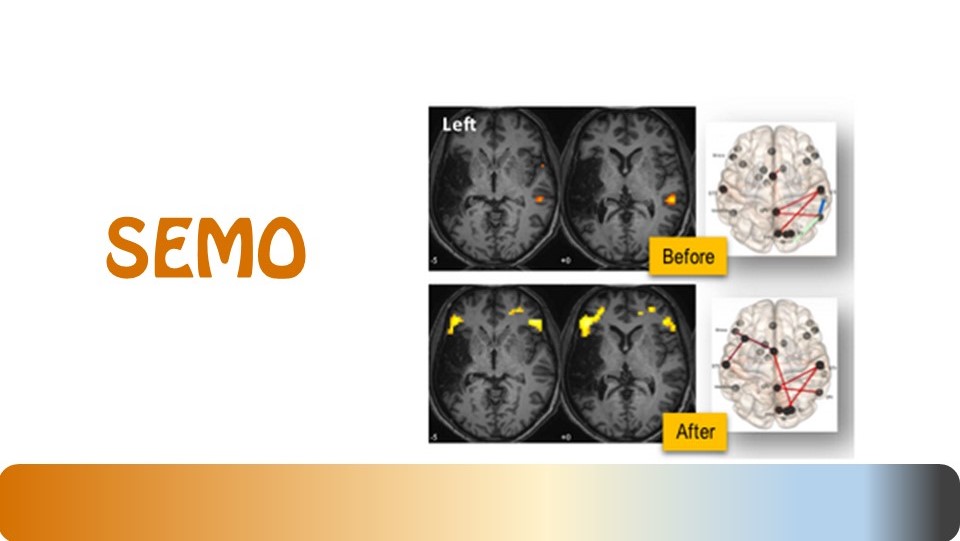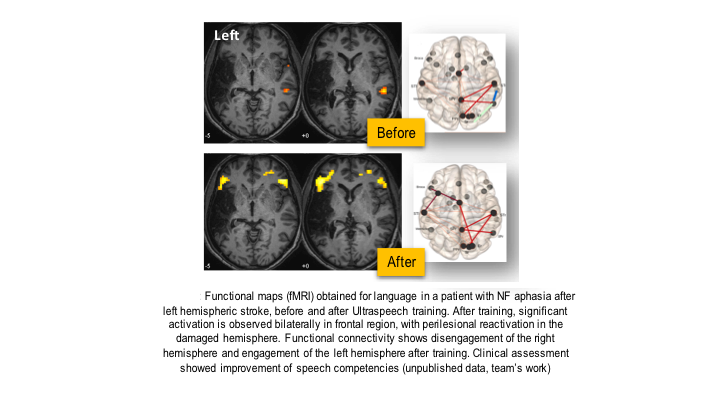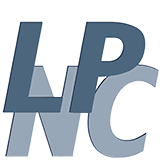- Share
- Share on Facebook
- Share on X
- Share on LinkedIn
Equipe Langage, Research

Sensory-Motor Integration for Speech Rehabilitation in Patients with Post-Stroke Aphasia
Monica BACIU
Hélène LOEVENBRUCK
Doctorante: Célise HALDIN
During a stroke, language-related areas of the brain can be affected, leading to aphasia. Of particular interest to us is expressive or non-fluent aphasia, which occurs after frontal lesions. These patients have the image of the word to be spoken, but cannot express it correctly, even though the speech organs are functioning perfectly. Aphasia requires re-education to regain the ability to speak. As a first step, the speech therapist will try to restore the failing function, or will propose methods that use the intact skills. Speech therapy rehabilitation reaches its limits fairly quickly after about six months. This explains the need for new programs and methods.
In this context, the new technological approaches developed in recent years, based on illustration and visual feedback, offer innovative therapeutic perspectives. In this project, we propose to evaluate the effectiveness of a rehabilitation program inspired by this type of approach, to improve speech in patients with non-fluent aphasia. Our method is based on the reinforcement of the interaction between perceptual and motor representations, thanks to the innovative Ultraspeech device. We will exploit a fundamental psycholinguistic principle, which postulates that speech is based both on the activation of the system controlling the motricity of effectors related to word articulation (action) and on the auditory or visual representation of words (perception). It is precisely this sensory-motor interaction that is impaired after a stroke in the frontal regions, and which explains the difficulties in producing words.
The sensory-motor interaction method that we propose allows the patient to perceive phonemes and visualize on a computer screen the movements of the tongue and lips previously recorded by a healthy speaker, typically a speech therapist. Through repeated exercises, the patient is trained to produce sounds correctly, using the correct pronunciation and articulatory movements of the reference speaker as a model. We will compare patients who will follow a classical speech and language therapy rehabilitation program to another group who will follow an ‘enriched’ rehabilitation program including rehabilitation based on sensory-motor interaction associated with speech and language therapy. In order to judge the favorable effect of the rehabilitation program including sensory-motor integration, the following measures will be considered: (a) language skills with speech therapy assessment, (b) phonemic quality with speech flow analysis, (c) inner speech abilities with an introspective questionnaire and a behavioral task and (d) cognitive function with neuropsychological assessment. Brain language networks will be evaluated with neuroimaging. The impact and spin-offs of the project are aimed at: basic and clinical research to better understand the basics of speech and aphasia; aphasic patients who need new methods and approaches to improve their disability; and health professionals who need better training and wish to use new methods from experimental research to treat patients.
Hélène LOEVENBRUCK
Doctorante: Célise HALDIN
During a stroke, language-related areas of the brain can be affected, leading to aphasia. Of particular interest to us is expressive or non-fluent aphasia, which occurs after frontal lesions. These patients have the image of the word to be spoken, but cannot express it correctly, even though the speech organs are functioning perfectly. Aphasia requires re-education to regain the ability to speak. As a first step, the speech therapist will try to restore the failing function, or will propose methods that use the intact skills. Speech therapy rehabilitation reaches its limits fairly quickly after about six months. This explains the need for new programs and methods.
In this context, the new technological approaches developed in recent years, based on illustration and visual feedback, offer innovative therapeutic perspectives. In this project, we propose to evaluate the effectiveness of a rehabilitation program inspired by this type of approach, to improve speech in patients with non-fluent aphasia. Our method is based on the reinforcement of the interaction between perceptual and motor representations, thanks to the innovative Ultraspeech device. We will exploit a fundamental psycholinguistic principle, which postulates that speech is based both on the activation of the system controlling the motricity of effectors related to word articulation (action) and on the auditory or visual representation of words (perception). It is precisely this sensory-motor interaction that is impaired after a stroke in the frontal regions, and which explains the difficulties in producing words.
The sensory-motor interaction method that we propose allows the patient to perceive phonemes and visualize on a computer screen the movements of the tongue and lips previously recorded by a healthy speaker, typically a speech therapist. Through repeated exercises, the patient is trained to produce sounds correctly, using the correct pronunciation and articulatory movements of the reference speaker as a model. We will compare patients who will follow a classical speech and language therapy rehabilitation program to another group who will follow an ‘enriched’ rehabilitation program including rehabilitation based on sensory-motor interaction associated with speech and language therapy. In order to judge the favorable effect of the rehabilitation program including sensory-motor integration, the following measures will be considered: (a) language skills with speech therapy assessment, (b) phonemic quality with speech flow analysis, (c) inner speech abilities with an introspective questionnaire and a behavioral task and (d) cognitive function with neuropsychological assessment. Brain language networks will be evaluated with neuroimaging. The impact and spin-offs of the project are aimed at: basic and clinical research to better understand the basics of speech and aphasia; aphasic patients who need new methods and approaches to improve their disability; and health professionals who need better training and wish to use new methods from experimental research to treat patients.

- Share
- Share on Facebook
- Share on X
- Share on LinkedIn
